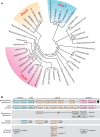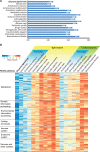Dicyemid Mesozoans: A Unique Parasitic Lifestyle and a Reduced Genome
- PMID: 31347665
- PMCID: PMC6736024
- DOI: 10.1093/gbe/evz157
Dicyemid Mesozoans: A Unique Parasitic Lifestyle and a Reduced Genome
Abstract
Dicyemids, previously called "mesozoans" (intermediates between unicellular protozoans and multicellular metazoans), are an enigmatic animal group. They have a highly simplified adult body, comprising only ∼30 cells, and they have a unique parasitic lifestyle. Recently, dicyemids were shown to be spiralians, with affinities to the Platyhelminthes. In order to understand molecular mechanisms involved in evolution of this odd animal, we sequenced the genome of Dicyema japonicum and a reference transcriptome assembly using mixed-stage samples. The D. japonicum genome features a high proportion of repetitive sequences that account for 49% of the genome. The dicyemid genome is reduced to ∼67.5 Mb with 5,012 protein-coding genes. Only four Hox genes exist in the genome, with no clustering. Gene distribution in KEGG pathways shows that D. japonicum has fewer genes in most pathways. Instead of eliminating entire critical metabolic pathways, parasitic lineages likely simplify pathways by eliminating pathway-specific genes, while genes with fundamental functions may be retained in multiple pathways. In principle, parasites can stand to lose genes that are unnecessary, in order to conserve energy. However, whether retained genes in incomplete pathways serve intermediate functions and how parasites overcome the physiological needs served by lost genes, remain to be investigated in future studies.
Keywords: dicyemids; genome; mesozoan; reduction; unique parasite.
© The Author(s) 2019. Published by Oxford University Press on behalf of the Society for Molecular Biology and Evolution.
Figures





Similar articles
-
Dicyema Pax6 and Zic: tool-kit genes in a highly simplified bilaterian.BMC Evol Biol. 2007 Oct 25;7:201. doi: 10.1186/1471-2148-7-201. BMC Evol Biol. 2007. PMID: 17961212 Free PMC article.
-
Unique genome of dicyemid mesozoan: highly shortened spliceosomal introns in conservative exon/intron structure.Gene. 2010 Jan 1;449(1-2):70-6. doi: 10.1016/j.gene.2009.09.002. Epub 2009 Sep 9. Gene. 2010. PMID: 19747532
-
Cloning of chitinase-like protein1 cDNA from dicyemid mesozoans (Phylum: Dicyemida).J Parasitol. 2007 Dec;93(6):1403-15. doi: 10.1645/GE-1290.1. J Parasitol. 2007. PMID: 18314687
-
Biology of dicyemid mesozoans.Zoolog Sci. 2003 May;20(5):519-32. doi: 10.2108/zsj.20.519. Zoolog Sci. 2003. PMID: 12777824 Review.
-
Gene family phylogeny and the evolution of parasite cell surfaces.Mol Biochem Parasitol. 2016 Sep-Oct;209(1-2):64-75. doi: 10.1016/j.molbiopara.2016.03.007. Epub 2016 Mar 21. Mol Biochem Parasitol. 2016. PMID: 27012486 Review.
Cited by
-
The complex evolutionary history of sulfoxide synthase in ovothiol biosynthesis.Proc Biol Sci. 2019 Dec 4;286(1916):20191812. doi: 10.1098/rspb.2019.1812. Epub 2019 Nov 27. Proc Biol Sci. 2019. PMID: 31771466 Free PMC article.
-
Metabolic Adaptations to Marine Environments: Molecular Diversity and Evolution of Ovothiol Biosynthesis in Bacteria.Genome Biol Evol. 2021 Sep 1;13(9):evab169. doi: 10.1093/gbe/evab169. Genome Biol Evol. 2021. PMID: 34272861 Free PMC article.
-
Highlight-Lessons on Parasitism from the Curious Dicyemida.Genome Biol Evol. 2019 Aug 1;11(8):2218-2219. doi: 10.1093/gbe/evz160. Genome Biol Evol. 2019. PMID: 31503288 Free PMC article. No abstract available.
-
Gene expression profiles of dicyemid life-cycle stages may explain how dispersing larvae locate new hosts.Zoological Lett. 2019 Nov 13;5:32. doi: 10.1186/s40851-019-0146-y. eCollection 2019. Zoological Lett. 2019. PMID: 31754455 Free PMC article.
-
Evolution of the Cdk4/6-Cdkn2 system in invertebrates.Genes Cells. 2024 Nov;29(11):1037-1051. doi: 10.1111/gtc.13165. Epub 2024 Oct 8. Genes Cells. 2024. PMID: 39380239 Free PMC article.
References
-
- Boetzer M, Henkel CV, Jansen HJ, Butler D, Pirovano W.. 2011. Scaffolding pre-assembled contigs using SSPACE. Bioinformatics 27(4):578–579. - PubMed
Publication types
MeSH terms
Substances
LinkOut - more resources
Full Text Sources
Miscellaneous

